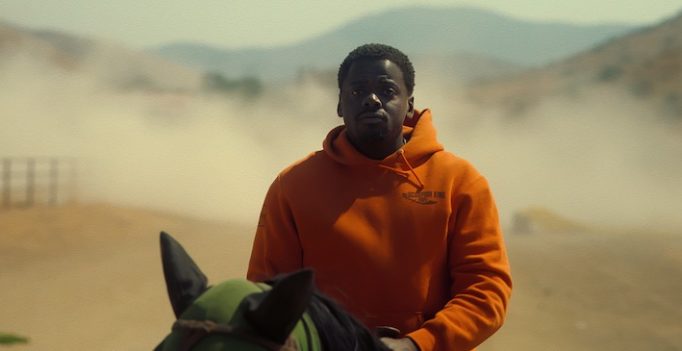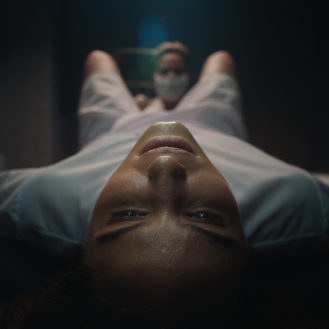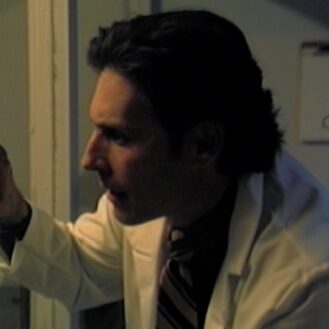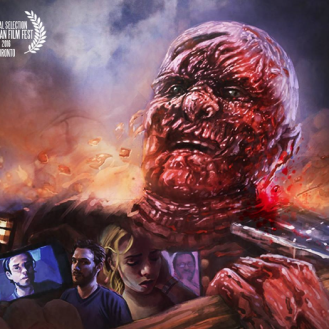By: Jolie Featherstone
Jordan Peele’s latest thriller Nope roars into theatres. Nope is grand in every way: open landscapes, blockbuster performances, and big ideas. Peele’s vision brings to life a number of ideas while keeping the story fully energized.
I will try to avoid spilling as much about the film as possible, as the rush of walking side-by-side with the characters is palpable. While watching, I repeatedly willed the characters to walk faster just so that I could uncover more of the mystery.
Peele reunites with Get Out leading man and Judas and the Black Messiah Oscar-winner Daniel Kaluuya as OJ Haywood. After witnessing his father’s (Keith David) sudden death in a freak accident, OJ is trying his best to keep up with the demands of maintaining his late father’s horse ranch. Stoic and strong, OJ is quietly struggling to get by. When he’s reunited with his sister, Em Haywood (Keke Palmer), we learn that they are the descendants of the first Hollywood star and stuntman seen in Eadweard Muybridge’s sequence of moving pictures featuring a Black jockey riding a horse (sadly, in reality, the jockey’s name still remains a mystery). The siblings have complicated feelings about what to do with the ranch. As strange events begin to happen, they start to suspect that their father’s death was not what it initially appeared to be. They soon realize that they are being preyed upon by an unknown predator at the ranch.
Nope is a sci-fi/horror for the modern age, with dashes of classic Hitchcock and Spielberg. It’s a different kind of haunted house story. Indeed, an acute moment through which we can establish the essence of the film is a scene which bears some resemblance to a scene in Steven Spielberg’s Close Encounters of the Third Kind in which the protagonist’s house is being rocked by an inhuman force. The scene is upsetting, but it’s not just the cold, heart-thudding fear of a horror movie. There’s an existential awe, a spiritual awe, that reverberates throughout.
Peele brings many thought streams to the film. He commences the film with a quote from the Bible, Nahum 3:6: “I will pelt you with filth, I will treat you with contempt, and make you a spectacle.” The quote references two main themes that I derived from the film: 1) the exploration of our obsession with spectacle and imagery, and 2) the idea that oppressors do not go unpunished.
Nope examines, at times even comically criticizes, humankinds’ gnawing obsession with documenting life through images. We don’t mind if our bodies and minds can be broken as long as we can get it in a spectacular video clip. The film references getting the “impossible shot”. As humans, we benefit from our role as apex predators yet we are also unsettled by the existential uncertainty that comes with our abilities. Perhaps it is because of the latter that we are obsessed with photographing the sublime. If we can photograph something, we can capture it in our own way; possess it in the form of a representation. We exalt images to such a degree that we ascribe ultimate truth to them. With the invention of the camera to take images of our reality (a feat that truly is remarkable when we stop and think about it), we shifted from oral histories and looked to images for their supposed “objectively factual” recordings of life.
Of course, we know that we must interrogate this “objectivity” by considering who is holding the camera. Who is the individual doing documenting and how are they doing so? What information comes with them and into their recordings? OJ and Em’s ancestor’s contribution to artistic history was erased by the people who held the pen – or camera in this case. Owning an image or representation of reality, means staking your claim on it. Indeed, in the film, one camera-holder’s beliefs takes away access from individuals with the most at stake.
At the same time, images can help humans speak truth to power. Documentation can crumple oppressors, colonizers, and gatekeepers. The fact that OJ and Em work through their differences in order to fight for their ranch, their careers, and their protection is an act of rebellion against the forces that would have taken that away from them.
A few interesting cinema tidbits: the film’s visual storytelling calls back to Hitchcock. Oz Perkins, child of Psycho star Anthony Perkins and director of Gretel & Hansel, plays a darkly funny role as a director. Toronto-born Michael Wincott appears in a beautifully cast role that puts his deep, grainy voice to excellent use (he was in the 2012 film Hitchcock and has acted in a number of horror films). Recently, while on the press circuit for Nope, Peele praised horror film director John Carpenter. Carpenter made The Thing which also starred Keith David. Nope is rife with homage to classic horror and sci-fi films, and many of the cast members have significant experience with genre films. All of the principal cast members are on their A-game, particularly Kaluuya, Palmer, and Brandon Perea who plays Angel Torres, an overzealous IT guy who entangles himself in the siblings’ plans. One of the film’s most shocking sequences features young newcomer Jacob Kim who gives a performance with weight and nuance.
Nope fuses horror, thriller, sci-fi, western, action, and comedy genres to create an exciting ride. Peele brings ambition, grit, and heart to the tale in a concoction that can be described as Spielberg-esque. It’s high-minded and idealistic while also being a big-screen crowd-pleaser. I would wager that Peele’s background in comedy writing partially informs his ability to combine the aforementioned elements so smoothly. Comedians have an astute understanding of uncomfortable human emotions. There’s a high emotional intelligence that Peele brings to his films that give them a sleek texture. The film was shot in IMAX by Christopher Nolan’s oft-collaborator cinematographer Hoyte van Hoytema which brings the scale of Peele’s vision to its full proportions.
The film left me with a few questions:
- There is a character who has a traumatic physical injury. We get a brief glance at their face which has been maimed. Is the film using a physical disability as a horror parlour trick? Or is there something more being said here?
- The credits note that the film had a connection to Quebec. I was excited to see this Canadian connection. However, I couldn’t find much information on it. I’d love to learn more about Quebec’s relationship to the film.
Peele’s focus on exquisite score and music supervision shines yet again. I appreciated the fact that he gave every instrumentalist a credit. I also appreciated his including a clip from a Gowan song (another Canadian artistic icon). Note: if you know Gowan’s hits, you may find a bit of foreshadowing.
Yet the extraterrestrial force isn’t the only villain. Those whose entitlement and arrogance misguidedly leads them to control nature are swiftly punished. The force in this film nods towards our endless, insatiable consumption: our constant access to unfettered information that we can devour indiscriminately, mindlessly, hungrily. As OJ discovers a method to avoid provoking an attack from the alien force, we are reminded to be more conscientious about what and how we consume images. Knowing when it is safe to look, and knowing when we should create barriers between ourselves and the on-going torrent of spectacle which surrounds us in this day and age.
**********
Do You Tweet? Follow These Tweeple:
Jolie Featherstone: @TOFilmFiles





Be the first to comment